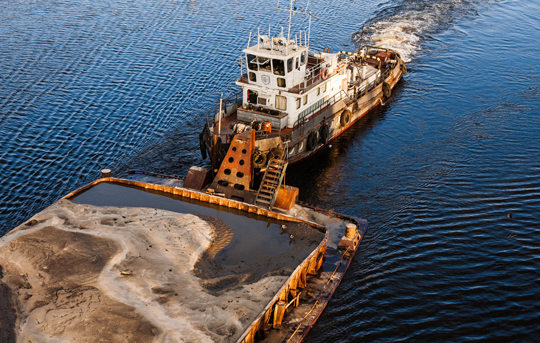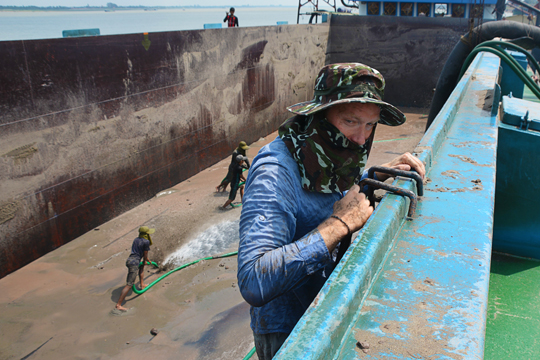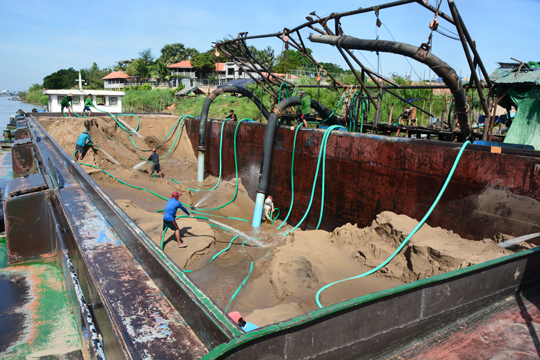Neither a market or a black market
Freiburg, Oct 10, 2019
Sand is in demand wherever cities are growing. Robert John has researched all the operations connected with the trade in sand, taking Cambodia, where construction is booming, as his example. And to meet demand, sand sometimes also trickles through dubious channels. John hopes his findings could help to moderate the negative effects of the trade.

Sand is one of the most mobile resources worldwide. Photo: finwal89/stock.adobe.com
“Ministry officials hid from me,” says Robert John. Taking Cambodia as his example, the Freiburg PhD student from the Institute of Geography is currently researching the trade in construction and filling sands: Cambodia is one of the largest regional providers of sand. A lot of building projects, companies and jobs there depend on the material. John is interested in the processes of marketization: what are the social, political, economic, geological and ecological factors and consequences connected with sand as a good? The research has been tricky: besides legal structures, there are also mafia-like ones involved in the trade in sand. Anyone who says too much risks trouble.
Grafting to gain trust
While some officials hid, John also encountered cooperative staff in ministries, helpful activists and sand workers. The PhD student found ways to gain new insights into the processes of marketization. He considered not only the point of view of participants in the market but also that of opponents of the sand trade, the consequences of which are not purely positive. So John incorporated the socio-political and geo-ecological effects in his analysis. To do this he combined a complex mix of methods. He investigated data from a distance, conducted interviews locally and even took part in market processes himself, in order to be able to observe them in detail. In order to do this, and because he had to be cautious with many of the sources of information, he labored with sand workers in the heat of Cambodia.

Robert John grafted in the heat of Cambodia – the workers learned to trust him and in return gave him information about the trade in sand. Photo: Robert John
“I couldn’t manage a whole working day,” John says. The extraction, loading and filling of sand are hard work. Machinery is used for many tasks, but there is still plenty of manual labor to be done: shoveling, hauling, controlling the hoses that a slurry of sand roars through at high pressure. “The pay is relatively good. But the workers pay with their health.” They are paid per cubic meter of sand extracted, and sand workers don’t just slave hard physically, but also fast and continuously – for up to twelve hours a day. After six to eight hours it was the end of the shift for John, a powerfully-built 6-foot tall man, “By then my hands and back hurt.”
Support and resistance
Why the graft? “Working together builds trust and enabled me to learn about the work routine in the sand trade,” explains John. What technical problems are there? What costs are there? At a sociable supper the PhD student gained information which he wouldn’t otherwise have learned, “I’d never have got concrete figures about things like the transport costs and wages otherwise.” Very few who earn from the sand trade are interested in transparency.
Unlike many other countries in South East Asia, there are non-governmental organizations (NGOs) and activists in Cambodia who oppose the sand trade and especially sand exports. Activists who made friends with John helped him and often interpreted for him – despite the risk: some were already in prison because they had photographed or trespassed on company land. “The worst thing that could have happened to me as a foreigner would have been expulsion,” the geographer says. Sometimes some of his official interview questions to official bodies got lost, or were simply not processed. When he appeared in person the doors were shut in his face. However, through private contacts the researcher got to know critical officials who were willing to give him information.

The workers load sand: “The pay is relatively good. But the workers pay with their health,” stresses Robert John. Photo: Robert John
Over two stays totaling over a year, John compiled a range of data – for instance more than 70 hours of recorded interviews, confidential legislative texts, more than 100 newspaper articles and numerous satellite images. “These can identify things like how much area a lake has lost through backfill and how much sand it’s used.” Now John is engaged in the analysis. In the end, he wants to publish a book setting out how the marketization of sands is integrated into urbanization processes and the flows of capital. He is also working together with the artist Michelle Reutter on an installation, “It offers new approaches and introduces the subject in a non-text-based way.”
A mobile resource
“It was Robert who introduced me to the exciting subject of sand in the first place,” says Annika Mattissek, Professor of Economic Geography and Sustainable Development, who is supervising John’s thesis. “At the same time, it is almost astonishing that the resource has had so little attention in the past.” In the end, after water, sand is the resource that is moved the most worldwide. Sand makes up the lion’s share of concrete and asphalt. By backfilling inland waters or coastal areas it is used to create new usable areas. Everywhere that cities are growing or the urban way of life is increasing, like in Cambodia, there is a massive demand for sand.
However, excessive sand extraction can destroy ecosystems, speed up the erosion of river banks, lower the groundwater level and have many other negative consequences for the environment. “Social conflicts are center stage to what we and the social sciences do,” Mattissek explains. The project has to identify all the connections. When his work is finished, Robert John wants to give a workshop in Cambodia to present his findings to all the major participants. “We want to feed back our results to them,” explains Annika Mattissek, “And we also want to encourage a dialogue between those in favor and those against the trade, officials and activists.” Maybe they will even find ways to reduce the damage from the trade in sand, without endangering the recovery of the country.
Jürgen Schickinger

